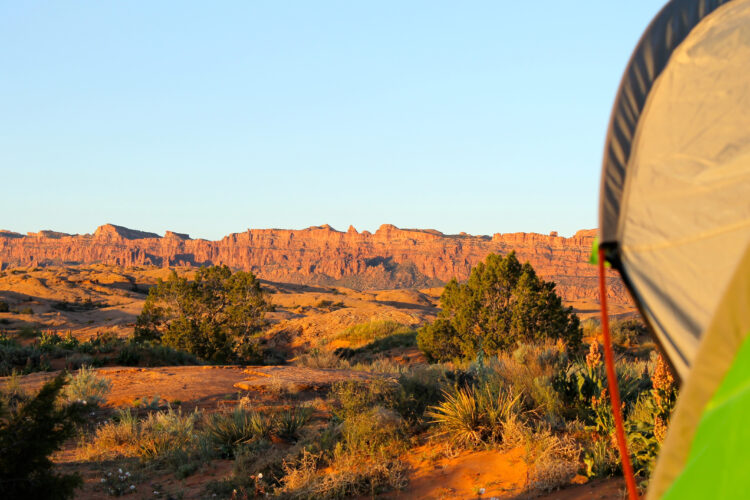
A major new mountain bike trail system could be coming to Moab soon. The BLM Moab Field Office is currently collecting public comments on a proposal to construct up to 25 miles of mountain bike trails south of town. The first phase of the project would create 9.75 miles of trails in a stacked loop configuration and could be shovel-ready as soon as spring 2024.
“People are pretty psyched,” Colin Topper told me over the phone. Topper is the Chair of the Grand County, Utah Trail Mix committee, a group that helps develop and maintain trails in the region. “This is going to end up being like two years from idea to shovel, which is just phenomenal on BLM land, and super nice,” he said.
In fact the site for the Mud Springs trail system was first identified back in 2008 and included in the Moab Field Office Resource Management Plan, referred to then as the Upper Spanish Valley Mountain Bike Focus Area. The project is designed help fill in several gaps among existing Moab trail offerings.
Plugging holes
While a few of the popular Moab-area trails like Slickrock are designated for both bicycles and motorized vehicles, Topper said most of the mountain bike trails built in Moab beginning in the early 2000s are not open to e-bikes. The trails at Mud Springs will be designed for Class 1 e-bikes from the start, giving pedal-assist riders more options in the area.
The draft environmental assessment prepared by the BLM says the Moab area currently has 150 miles of mountain bike trails organized into 12 stacked loop systems, though few of the existing trails are accessible to adaptive riders on handcycles. Plans call for seven miles of the phase one trails to be at least 36in wide, up to 48in.
NICA participation has been growing as well, the document notes, and the student athlete-friendly Moab Brand Trails can’t accommodate large-scale youth mountain bike races and events. With a seven-acre trailhead parking lot, Mud Springs will be in a much better position to handle big events.
Finally, both Topper and the BLM note that Moab is seeing both residential and tourist growth south of town and into San Juan County where the Mud Springs site is located. “That’s a big one, just having something south of town where most of the growth is happening,” Topper says. The upshot is fewer car trips through town to access trail systems to the north, and the hope is to eventually have a paved path connecting visitors and residents to the new trails.
The Mud Springs site
The Mud Springs site is located 12 miles south of Moab in the hills east of B Road 129. There’s currently dispersed camping and some off-road use in the area, and Topper says the name Mud Springs is fitting due to the high clay content in the soil. With that in mind, the project proposal calls for seasonal closures to prevent damage, and also to minimize any wildlife impact.
Regular visitors to Moab may be familiar with the Behind the Rocks trails, which are located on the other side US Highway 191 from the Mud Springs area. Considering events and additional visits generated by the new trail system, the BLM environmental assessment projects an overall economic impact of roughly $7.8M.
With the opening of the fourth section of the Raptor route, and plans for more bike trails in the new Utahraptor State Park north of Moab, visitors will have plenty of new trails to explore.

The trails
The cost to build the first phase of the Mud Springs trail system is projected to be in the hundreds of thousands of dollars, and will be funded mainly through Utah Outdoor Recreation grants awarded to Grand and San Juan counties. Grand Country Trails is slated to design and build the trails.
Unlike many of the existing Moab-area trails, the phase one trails at the Mud Springs system will be machine built. This allows builders to make the trails wide enough for accessible use, and will ensure the trails located closest to the parking area are suitable for beginner to intermediate riders. According to the BLM proposal, climbing trails will be kept to a 7% grade or less.
A future Mud Springs build phase will likely add more advanced, hand-built trails. Then again, Moab already already has plenty of rugged trails.
“I think one of the things that people are so excited about with this new trail system is the prospect of it being machine built,” said Topper.





















5 Comments
Nov 19, 2023
Nov 17, 2023
Nov 23, 2023
Nov 18, 2023
Jul 25, 2024
More here: https://www.moabtimes.com/articles/mud-springs-mountain-bike-trail-system-receives-350k-in-grant-funding/